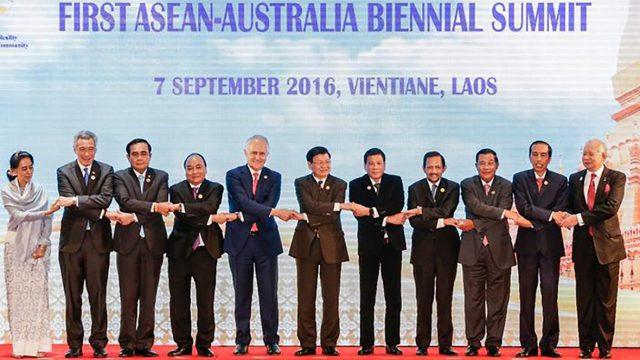Southeast Asia comes to Sydney: meeting, message, meaning & mateship
Posted By Graeme Dobell on March 13, 2018 @ 06:00

ASEAN comes to Sydney this week. The harbour city hosts Southeast Asia as Malcolm Turnbull does summitry with ASEAN’s leaders.
Just back from the Washington DC celebration of 100 years of US–Australia mateship, the prime minister will preside over a different set of discussions about Oz mateship with Southeast Asia.
The leaders’ meeting on the weekend (17–18 March) is the first ASEAN summit on Australian soil; it follows from the launch of this biennial event in Laos in 2016.
As in Vientiane, the public face will be all smiles and interlinked hands. At the photo-op level, the summit acts as semaphore—the meeting is the message. Sydney has lots of meetings to add layers of meaning to the message: a deeper and richer Oz–ASEAN mateship for the Asian century.
The ASEAN–Australia week [1] features academic, educational, sporting and cultural events to ‘highlight the depth and diversity of links between Australia and Southeast Asia, and showcase Australian institutions’ engagement with ASEAN countries’. Sitting high up the mountain, close to the leaders, there’s the Counter-Terrorism Conference [2] and the Business Summit [3] (with both a CEO forum and an SME conference).
For a typically authoritative discussion of the meanings to be drawn from the meetings, see Dr Frank Frost’s parliamentary library paper on the issues and implications of the summit [4]. He concludes by identifying these major factors in Australia’s future relations with ASEAN:
- ASEAN’s progress towards its declared goals for economic integration and security cooperation—the Community project—will be crucial.
- The increase in great power tensions and decline in strategic trust between China and the US will ‘increase pressures on ASEAN and reduce its capacity to continue to be a viable diplomatic actor in East Asia’.
- Whether ASEAN’s efforts at multilateral dialogues, centred round the East Asia Summit, can build security in East Asia.
- The character and evolution of Australia’s institutional relationship with ASEAN.
- The health and viability of Australia’s bilateral relationship with Indonesia.
My view of the future is that Australia should aspire to more than mateship—we should seek membership. My ASPI paper Australia as an ASEAN Community partner [5] discusses how and why Australia should aim for a form of ASEAN membership/partnership by 2024, the 50th anniversary of Australia becoming the first ASEAN dialogue nation.
Responding to that mateship-to-membership idea, Dr Huong Le Thu comments that Oz perspectives on ASEAN have fluctuated from fearful to fascinated [6], along with periods of neglect and the odd blind spot depending on Canberra’s political mood:
Australia’s varying attitudes towards ASEAN has resembled a drawing class exercise on getting perspective right. Australia has been outside, in front of, behind, beside, overlooking, far away, close up and, one day, may even be inside ASEAN. Let’s hope that its enthusiasm doesn’t burn out after the summit, and that Canberra’s current fascination isn’t just a passing phase.
Enthusiasms may, indeed, wane. Necessity is a more constant spur. Australia and ASEAN meet at a time when ‘big and often disconcerting geopolitical shifts have been occurring in the region, most of them happening faster and going further than almost any of us would have believed possible’. The quote is from Gareth Evans, meditating on Asian geopolitics in transition [7].
Evans lauds ASEAN as ‘one of the world’s great conflict prevention success stories’ playing an important ‘strategic convenor’ role, but he worries that the association’s coherence and credibility is deteriorating. China presses. ASEAN’s ‘brand’ is tarnished by the retreat from democracy and rule of law by some of its members.
Time for Australia to step up, not step back. Tough times sort out your best mates.
Gareth Evans thinks the Sydney summit is the moment to start exploring some form of Australian membership of ASEAN:
If ASEAN could better harness its own collective middle-power energy and capacity, and work more closely with countries like Australia, it could be a more influential and effective regional security player than it now is, in particular pushing back in the South China Sea against China’s increasingly assertive encroachment: a united front of middle powers might be more effective in resisting this than relying on the United States.
The mateship message needs to become a mutual musing about membership. The strategic dimension is what Australia, as a fellow middle power, can bring to ASEAN’s efforts as a middle-power grouping seeking to shape Asia’s norms and strategic system. Economically, Australia stands to benefit mightily from an ASEAN Community able to deliver a middle-class future to its people and push beyond the middle income trap.
The meaning of the Sydney picture of ASEAN leaders linking hands with Australia’s prime minister must be more than photo-op symbolism.
Article printed from The Strategist: https://aspistrategist.ru
URL to article: /southeast-asia-comes-sydney-meeting-message-meaning-mateship/
URLs in this post:
[1] ASEAN–Australia week: https://aseanaustralia.pmc.gov.au/asean-australia-week
[2] Counter-Terrorism Conference: https://aseanaustralia.pmc.gov.au/special-summit/counter-terrorism-conference
[3] Business Summit: https://aseanaustralia.pmc.gov.au/special-summit/business-summit
[4] issues and implications of the summit: https://www.aph.gov.au/About_Parliament/Parliamentary_Departments/Parliamentary_Library/pubs/rp/rp1718/ASEANSummit
[5] Australia as an ASEAN Community partner: https://www.aspistrategist.ru/report/australia-asean-community-partner
[6] fluctuated from fearful to fascinated: /australias-ever-changing-perspectives-asean-time-get-right/
[7] Asian geopolitics in transition: http://www.gevans.org/speeches/Speech644.html
Click here to print.